| Thermodynamic
Footprints |
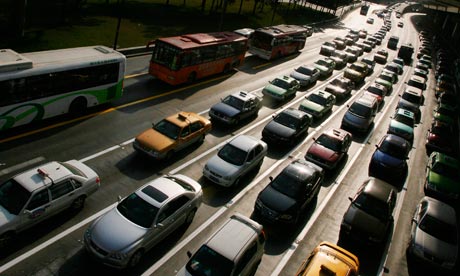 This article introduceces
the concept of the human Thermodynamic
Footprint. There
are graphs... This article introduceces
the concept of the human Thermodynamic
Footprint. There
are graphs...In 1975 the Canadian ecologist and population activist Dr. Jack Vallentyne introduced to the world a concept he called the "Demotechnic Index". It is the ratio of the amount of all technological energy a person uses in a day (energy from oil, gas, coal, hydro and nuclear power) over the average amount of energy they get in a day from the food they eat. This article examines the state of the world in terms of that index, which I have taken the liberty of renaming the Thermodynamic Footprint or TF. I did that to make the term a little more accessible, and also in the spirit of the times - many of the people who read this will already be familiar with concepts like the Carbon Footprint and the Ecological Footprint. The TF is intended to measure the impact we are having on the planet as the result of our use of technological energy. It also allows us to measure the change in our impact over time. The TF is really a measure of human activity. All human activity is made possible though our use of energy, and our energy-driven activity is what alters the planet's physical, biological and chemical makeup - through mining, manufacturing, construction, habitat alterations, and the generation of wastes such as carbon dioxide, garbage and other pollution. Because of this, our energy use is the best available proxy or representative for our overall impact on the planet. TF should therefore be understood as a measure of the impact we are having on (or damage we are doing to) our planet's life-support systems. Definition The Thermodynamic Footprint is the ratio of all the energy a person normally uses in a period of time, over the amount of energy they generate within their bodies from food. The "energy we normally use" includes fossil fuels and non-fuel generated electricity from hydro, nuclear and renewable sources such as wind and solar power. It includes both our own direct energy use and our individual share of all the energy society uses to create and maintain the world we live in. The result is a number, expressed in units I call Human Equivalents or HE. The number describes how many times a person's environmental impact is multiplied by their technological energy consumption. If someone used no additional energy beyond the food they ate, their TF value would be 1 HE. If their TF is 2 HE, it means they have twice the impact on their environment as someone who used no additional energy. Someone with a TF of 10 HE has the same impact as ten people without energy assistance.. How is the TF Calculated? The TF calculation begins with the amount of technological energy a person uses. This is commonly called "primary energy", and can be expressed in terms of electricity (watt-hours) or oil equivalents (expresses as "tonnes of oil equivalent" or TOE). Although thermal and electrical energy are not completely comparable, data sources such as the BP Statistical Review of World Energy provide standard factors that allow us to convert them all to a common basis. This number is then converted into the number of watts of power a person uses, which becomes the numerator of the TF. The denominator of the TF ratio is the amount of power a person gets from the food they eat. In order to make the calculations a little simpler, a standard value of 125 watts is used. This value is also added to the numerator, so that if a person used no additional primary energy, their TF would be exactly 1. If a person used no primary energy at all (like an ancient hunter-gatherer) their TF would be calculated as (0+125) / 125 = 1 HE If a person's share of primary energy is 1250 watts their TF would be calculated as (1250+125) / 125 = 11 HE A Basic Assumption The core assumption of this approach is that all energy use creates an environmental or ecological impact. While we are used to thinking of the impact of the energy sources themselves (for example, the CO2 and other pollution from burning fossil fuels; radioactive contamination from nuclear reactors; the mountaintop damage of coal mining; etc.) the impact of energy goes far beyond those initial effects. Energy enables all human activities, from agriculture to city-building, from dredging waterways to digging mines. Every human activity contributes to a web of direct and indirect environmental impacts that are independent of the source of the energy that is used in the activity. What about other forms of energy? Humans were already using a substantial amount of non-food energy well before 1800. Even before the discovery of agriculture some 10,000 years ago, our ancestors were already using firewood and other biofuels, oxen, horses, donkeys, yaks, dogs, etc. to do some of the work that had to be done. If we count all of the energy (and CO2) produced by biomass fuels and and draft animals, that would seem to add quite a lot to the human footprint. However, the TF deliberately omits these sources of energy from the calculation and focuses solely on our use of technological primary energy sources. There are several reasons for this.
As a note, I do consider the pre-industrial sources of environmental damage like desertification and deforestation below. They are just not included directly in the TF calculation. Data Sources The data sources include the BP Statistical Review of World Energy 2012 and the World Bank's database of World Development Indicators. Results First, here is the Thermodynamic Footprint of a single "average" world citizen at since 1800: 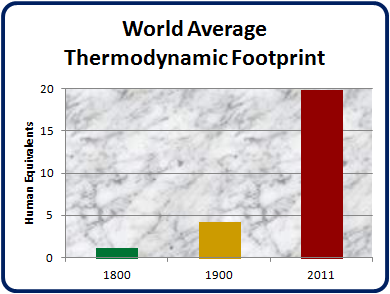
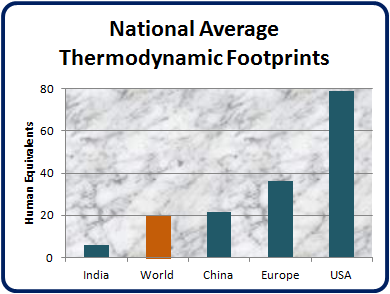
This technique also lets us determine how the Thermodynamic Footprint of nations has changed over time: 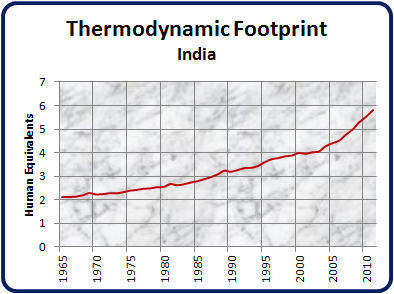 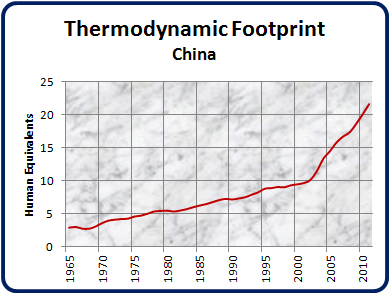 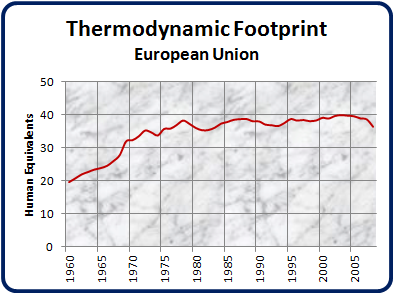 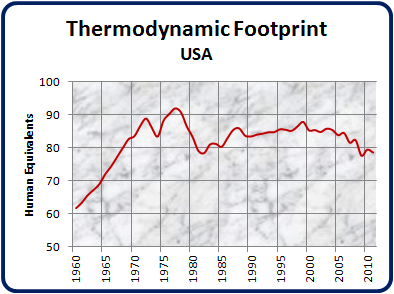 The Human Equivalent The unit of the Human Equivalent or HE is similar to the concept of the "energy slave". Each of us represents the operation of some quantity of primary energy within our environment. That energy (plus the food an individual consumes) represents the work of a number of "human equivalents", a number that is given by our Thermodynamic Footprint. World Thermodynamic Footprint Since 1800 The next graph may be the most interesting. By multiplying the average global TF figure by the actual world population, we can find the "Human Equivalent" population of the world over time. This value reflects both our increasing energy consumption and our growing world population. It is a measure of the increasing planetary impact of the combined growth in our technology, activity and numbers. 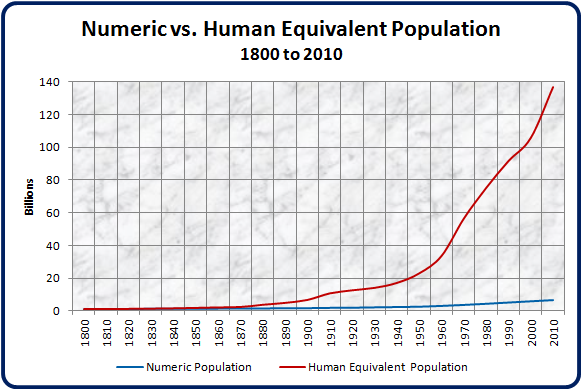
Of course, our activity is not spread out evenly across the planet. Some areas see very little human activity, while others have quite a lot. If we estimate that one third of all the world's land is used by humans in one way or another, this brings the average HE density of the areas that are subject to human impact up to 8000 human equivalents per square mile. This is just about half the the population density of Hong Kong - living and working on every habitable square mile of the planet. I = PAT The famous equation "I = PAT" was introduced by Paul Ehrlich and John Holdren in the 1970s to express human environmental impact. In it, the impact (I) is calculated as our population (P) times our individual level of activity (A) times a technological multiplier (T). While we can measure P directly, finding good representatives for A or T (or for the combination of A x T) is quite difficult. As Jack Vallentyne noticed over 35 years ago, the Thermodynamic Footprint is a very good proxy for that elusive "AT" term. By using it this way we can determine that humanity today is having 135 times the impact on the planet that we had just 200 years ago. Conclusion The Thermodynamic Footprint, expressed in Human Equivalents, quantifies in general terms the amount of damage that our technological activity is causing to the planet's life-support systems. This activity, driven by the energy we use in our daily lives, causes as much damage to the planetary systems we depend on as 135 billion people would if they were living in their raw human state, as hunter-gatherers. It is estimated that there were about 5 million people living on the planet just before the invention of agriculture 10,000 years ago. Modern human civilization today has about 27,000 times the impact on the planet as did our ancestors of that time. In the face of this degree of pressure, it is no wonder that our activity is damaging the world's atmosphere, geology, water chemistry and living ecology as profoundly as it is today. The 64 trillion dollar question is, "How close are we to the point where the Earth's systems can no longer cope with these changes, and finally force us to cease and desist?"
Bodhi Paul
Chefurka
|
| This
article may be reproduced in whole or in part , in any manner and for
any purpose whatsoever, with no restrictions. |